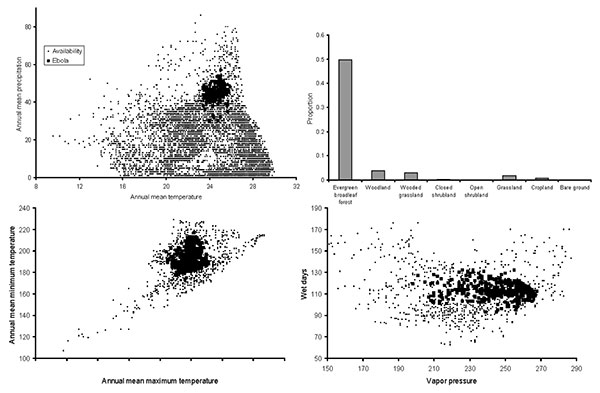Volume 10, Number 1—January 2004
Research
Ecologic and Geographic Distribution of Filovirus Disease
Figure 3

Figure 3. Ecologic distribution of predicted potential distributional areas for Ebola hemorrhagic fever (HF) occurrences, visualized in a few dimensions of climate. (A) Large-scale view (all of Africa), in which the basic concentration of Ebola HF occurrences in hot, wet climates is shown. (B) Distribution by land use/land-cover type, summarized as the proportion of overall area of land-cover types that is predicted to be present at the highest confidence level. (C,D) Regional scale (distributional area predicted by all 20 best-subsets models for Ebola HF buffered by 200 km in all directions) view of the ecology of occurrences of Ebola HF, visualized in dimensions of annual mean minimum temperature, annual mean maximum temperature, wet days, and vapor pressure.
1Although filovirus taxonomy undergoes frequent revision, we follow nomenclature most recently established by the International Committee of Taxonomy of Viruses in 2002. Filoviruses consist of two genera. The genus Marburgvirus contains one species, Lake Victoria marburgvirus, with several recognized strains, and Ebolavirus contains four species: Ivory Coast ebolavirus, Reston ebolavirus, Sudan ebolavirus, and Zaire ebolavirus. For simplicity, we refer to the viruses using the unitalicized vernacular (e.g., Ebola Zaire). We use “Ebola viruses” to refer in general to members of Ebolavirus and “Marburg viruses” to refer in general to members of Marburgvirus. The diseases caused by filoviruses are termed Ebola hemorrhagic fever (HF; diseases caused by Ebola viruses) and Marburg HF (diseases caused by Marburg viruses).